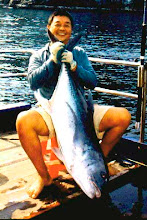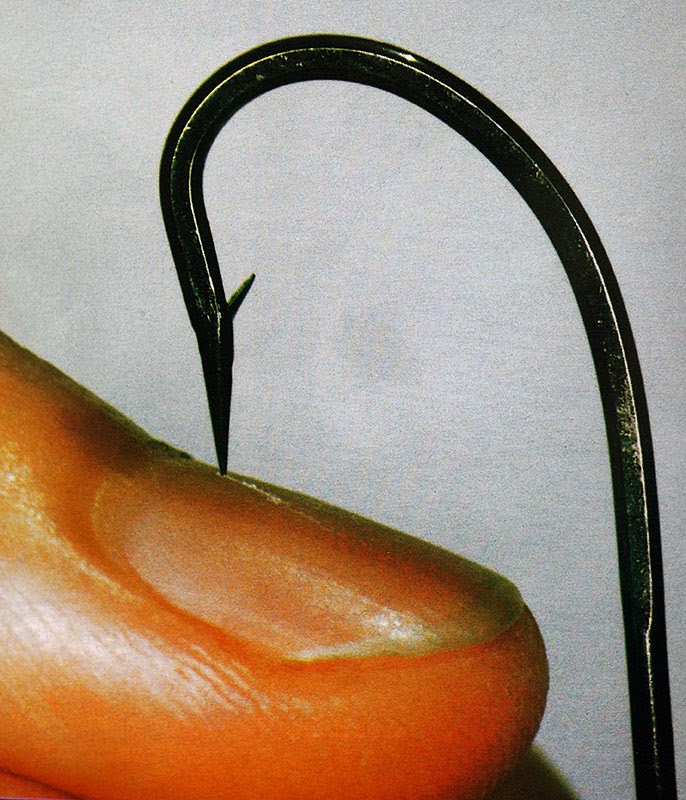This article was published in the September 2001 issue of Rod and Line fishing magazine.
Hmmm, the steamed bujuk tasted fantastic. We were having a bujuk meal at Tan Soon Wai's stall, when Liau Swee Onn (he contributed the bujuk) told us about his secret spot. For two over years, he and his friends made regular trips here for bujuks. To access this spot, they got to travel by motorbikes, carrying all their gears and an inflatable. It was a real tough journey as all journeys through oil palm estates are. Reaching the bank they then inflated the boat and crossed the river to reach the swampy jungle, which was their hunting ground. As the inflatable could only accommodate two persons, they had to take turn to cross. After rowing across the boat would then be reeled back with a fishing line tied to it (most anglers are very innovative fellows). On further inquiry, I guessed the river to be Sugai Tumbuh near Pengkalen Nibung area. We finally decided to access the swamp by travelling up river by boat.
 |
| The boat landing, where En. Din has his drink stall. The main road and the bridge are in the background. |
Cruising slowly along, I noticed the current was unusually strong. This river being widened and deepened along its whole lenghth, was no longer the slow flowing river that we once knew. We never really went on plane as there were a lot of sunken trees and branches being washed down by the current. It was good that we were travelling slowly as there were plenty of residential storks, egrets and other waterfowls feeding on both sides of the banks. The whole flock would fly up together on the approach of our boat. The sight itself was worth all the efforts that we had put in to come. Gliding with the wind, they sure looked graceful in the morning sky. Sweeping from left to right and up and down, one could only sigh and drink in the poetic motion being played in front of us.
 |
| Soon Wai and his bujuk. |
Finally we reached our destination. A week ago, Swee Onn caught quite a number of kilo size bujuks here. Climbing on to the bank after putting on our wading boots, (I never allow anyone to wear wading boat on the boat for safety reasons) we began to struggle forward. The bank was a whole layer of soft mud dug up from the river. The trick was to step on the branches and stumps of roots. With wading boots it was never easy. One misstep would find us sinking right up to our knees. To extract our legs, we had to exert and pull slowly until our legs were free. If you pull to fast and hard, you either lose a boot, suffer from hernia or worst, lose a leg. With the hot weather now prevalent, our strength was drained in a short time, struggling in the mud trap. Sweating and panting, we began flipping our baits. Small rejected carps from the aquarium shops were our baits. Compared to last week, the water level had fallen substantially, according to Swee Onn. As such, our catches were mostly 500gms and below. All of them should be thankful as we were in benevolent mood and all were released.
 |
| This was our fishing ground. The river was behind the angler. |
We moved upriver to a small pool of water parallel to the main river. Due to the deepening and widening of the Tumbuh River, the swamps on both sides were already drying up. As it was of higher level to the river, the water draining from the swamp has got to flow into this pool of water first. We correctly theorized that many of the bujuks, forced out of the swamp, must be taking refuge here . We were proven right as on my first cast, my bait was stolen. The take was too fast for me to react. The second cast got me a small bujuk. When my line moved again I struck hard and my line came back minus the hook. Cursing myself for being so careless for not checking for weakened lines, I retied and landed another cheroot. All in all I caught and landed nine small bujuks and a kilo size toman. Well, at least I could console myself that my broken line was not due to my carelessness. I released all my fish. Swee Onn's disbelieving look when informed of the releases told the whole story. I gave up explaining about conservation long a go.
 |
| Swee Onn struggling through the mud with Soon Wai in the foreground. |
Soon Wai fishing 10 meters away, was more productive. He kept on hitting fish after fish. This was only his second experience at bujuk fishing., but he was getting all the bites and all were above a kilo in size.The moment his bait hit the water, a burst of tiny bubbles could be seen floating up. Most of his fish were lost at the end stage of the fight when the fish gave a final burst. He was using 'no contact point system' fighting technique for street fighting brawls.He forgot that these bujuks were slump dwellers. As such sportingly thin line and light drag setting would not work here. More appropriate, would be the elbows, knees and teeth (on the ear if possible). Out of the more than fifteen strikes, he landed only two. Swee Onn landed one of presentable size.
 |
| This patch of dried grass produced the most fish. |
When another boatload of anglers from Lahat joined us, we were already worn out. With the hot sun burning mercilessly on us plus the struggle through the mud all but physically drained us. Surprisingly the newcomers immediately began to land fish. Mr. Chan was landing fish after fish from a clump of grass on the opposite bank. More than eight strikes were registered and he landed six good size bujuks.
 |
| This was how we rigged our baitfish. |
One surprising thing here was we never encountered any haruans. All the bujuks were rounded and in very good physical conditions. Sadly though with the extensive widening and the deepening of a few rivers in the Lower Perak region, the swampy jungles of this region will be a thing of the past. With it will vanish our productive fishing ground and the plentiful water bird populations too. Well, nature lovers' and anglers' losses are planters' gain I supposed.
 |
| The Lahat folks with my gang and some of our catches. |
Leaving our new friends to carry on fishing we pointed our boat down river. Suddenly, a two kilo plus toman shot out of the water, crossed the stern of our boat and dropped back into the river. I wonder how Soon Wai (he is rather handsome) will look if the toman. with saw-like dentures, hit him in the face. Five minutes later a deja vu occurred with a smaller toman. Swee Onn was wishfully saying how nice if the fish landed on the boat. (Well, I wasn't sure I like ferocious, panicky tomans landing in our midst). All too soon we crossed under the bridge spanning the river and were back at the landing where En Isa Din has his stall selling drinks. He has a few boats for hire too.


















